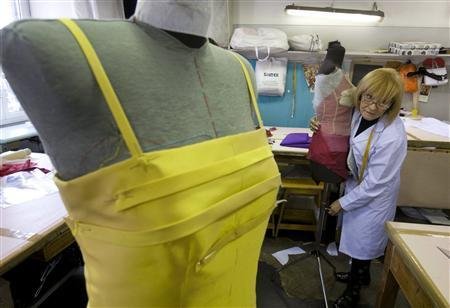Reuters
Feb 26, 2009
Rome haute couture pleads for help
Reuters
Feb 26, 2009
By Deepa Babington
ROME (Reuters) - Everyone in Italy's clothing industry is begging for state aid, but some of the loudest cries for help are coming from the exclusive haute couture segment known more for sequined extravagance than humble pleas.

Rome's couturiers -- who included the likes of Valentino and Roberto Capucci in their heyday -- are struggling as even the super-rich cut back on the custom-fitted, hand-sewn dresses that can easily cost 10,000 euros ($12,740) or more.
Couturiers face strong competition in their bid for aid as a growing list of players in Italy's 66-billion euro fashion sectorextend open palms amid a deepening recession.
Italy has already pledged $1.7 billion in aid to carmakers and over $15 billion for banks, and the fashion sector is lining up in hopes of being next, pointing to a 4 percent slide in sales last year and forecasts of a 5 percent fall this year.
At the high end Gattinoni, one of Rome's oldest fashion houses, says its haute couture sales slid 40 percent last year to prompt the first loss in its 62-year history, and organizers of Rome High Fashion week that ended this month say the crisis forced three stylists to abandon plans to participate.
"Until about two years ago you could just about maintain an atelier, but the crisis has dealt us the final blow," Gattinoni Chairman Stefano Dominella told Reuters at his atelier, where tailors measured silky fabric and sewed beads on to bustiers.
He rejects arguments that the luxurious world of haute couture is an unlikely candidate for state support.
Rome's couture scene may lack the glamour of Paris and has shrunk to a handful of houses like his, but the roots of Italian fashion lie in its ateliers that are veritable "museums" housing archives of sketches and time-honored techniques, he said.
"We are the smallest and the easiest to rescue," he argued, citing sales of 1-2 million euros a year for most couturiers: "If you had to choose between saving a museum and saving a fashion (chain) outlet, which one would you choose?"
With the help of fashion dynasty member Santo Versace, who is also a lawmaker in the ruling coalition, Dominella has begun lobbying the government for 30 percent tax breaks.
IMPOSSIBLE INTERVENTION
Miffed that fashion was recently overlooked for aid in favor of the appliance and furniture industries, the head of the fashion lobby Sistema Moda Italia told Senate lawmakers on February 17 that Italy's clothing sector risked "going to pieces."
Already weighed down by the third-largest debt pile in the world, Italy's government is unlikely to favor haute couture amid all the competing demands for aid, says Armando Branchini, head of InterCorporate, a fashion consulting firm.
"If having culture, craftsmanship and tradition is the reason to get aid, then that would be true for 99 percent of Italian consumer goods," he said. "Frankly, an intervention for haute couture in Italy would be impossible and meaningless."
Haute couture represents only a fraction of Italy's clothing sector and the government would be more likely to consider help for the broader textiles and fashion industry instead, he said.
While they wait for the government to act, Roman couturiers are busy looking at other avenues to drum up business.
Dominella, for example, suggests opening up the ateliers to tourists or including couture presentations in travel packages offered by luxury tour operators.
Sylvio Giardina of the Rome-based Grimaldi Giardina couture duo favours state aid but says just having the sector overseen by Italy's culture ministry rather than the tourism portfolio would help.
"Fashion is often considered something trivial, but in reality it maintains historic values and ancient craftsmanship," said Giardina, who estimates sales fell 40 percent last year after a sharp slowdown in the last four months.
"If the artisans doing it disappear, so will high fashion."
One stylist who is already adapting to the new reality in the couture world is Sicilian designer Marella Fererra, who says the demand is now for couture that is cost-effective.
"I'm still dressing the same families, but instead of ordering outfits for 25,000 euros that they once did, now they want to spend 7,000-10,000 euros," she said.
The crisis is simply laying bare a systemic change in Italian haute couture, she says: costs have spiralled, infrastructural support has withered and orders for 3,000-euro dresses are replacing those for 50,000-euro stunners.
She is tailoring her offerings to lower-priced outfits.
That's a far cry from when she started as a couturier 16 years ago. Then fashion industry chief Giuseppe Della Schiava would gift new designers fabric from his textiles business and feature them in his Italian Harper's Bazaar magazine, she says.
"It was a system that worked for everybody," she said.
Nonetheless, other fashion maestros still scoff at the idea of wholesale change to the couture business.
Renato Balestra, a longtime stalwart of Rome haute couture, says even though his house's sales have felt the pinch he has little faith in government aid and does not see the point of compromising on standards or surrendering to gloom.
"If you want to do a collection of haute couture, then you have to do it as haute couture and not like it's pret-a-porter," Balestra said. "There is a crisis, yes. But you can't go live in a cave just because there's a crisis."
(Editing by Sara Ledwith)
© Thomson Reuters 2024 All rights reserved.

























